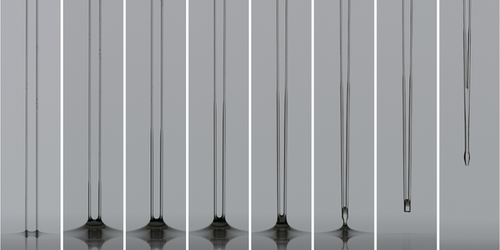Dynamic Cheerios Stickier than Static Ones
Pour Cheerios into milk and the oaty Os will likely clump together in both the middle of the bowl and around the edges. This phenomenon, called the Cheerios effect, has been known since the 1950s and is caused by a surface-tension-induced force that deforms the air–liquid interface around each floating Cheerio such that the Os get pulled together. This “sticky” force has been thoroughly studied, but little is known about that force’s impact on a dynamical system, for instance, a floating object being lifted off a liquid surface. Now Hadrien Bense and co-workers at the Université libre de Bruxelles show that for a thin glass rod being withdrawn from a silicone-oil bath, the attractive force is at least one order of magnitude higher than for its static counterparts [1].
For their experiments, Bense and colleagues pulled either one or two identical thin glass rods from the silicone oil. They recorded the process on video and then extracted information about the system from the videos’ frames. For a single rod, they measured the height to which the liquid climbed up the sides of the glass stick as a function of retraction speed. They found that this height was greater for a dynamic rod than for a static one and that it increased with increasing speed, following a power law. For two rods, the researchers determined the height of the liquid bridge that spanned the glass tubes. They found that the height of this bridge was a superposition of the liquid-climbing height for two single rods. A higher bridge implies a stronger attractive force and thus a greater Cheerios effect. Both results match predictions from analytical formulas that the team derived.
–Agnese Curatolo
Agnese Curatolo is an Associate Editor at Physical Review Letters.
References
- H. Bense et al., “Measurement of capillary forces using two fibers dynamically withdrawn from a liquid: Evidence for an enhanced Cheerios effect,” Phys. Rev. Lett. 131, 184003 (2023).




